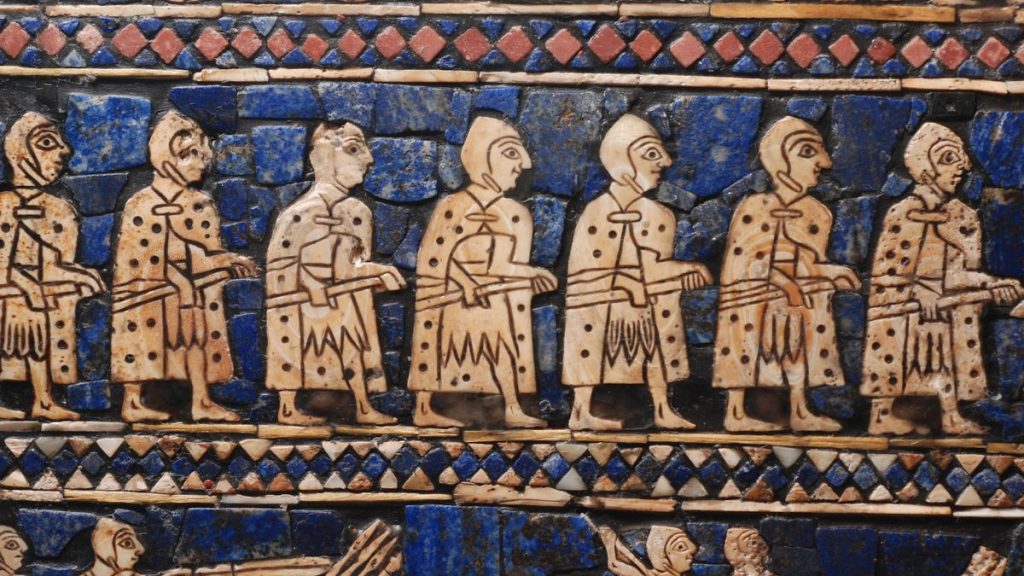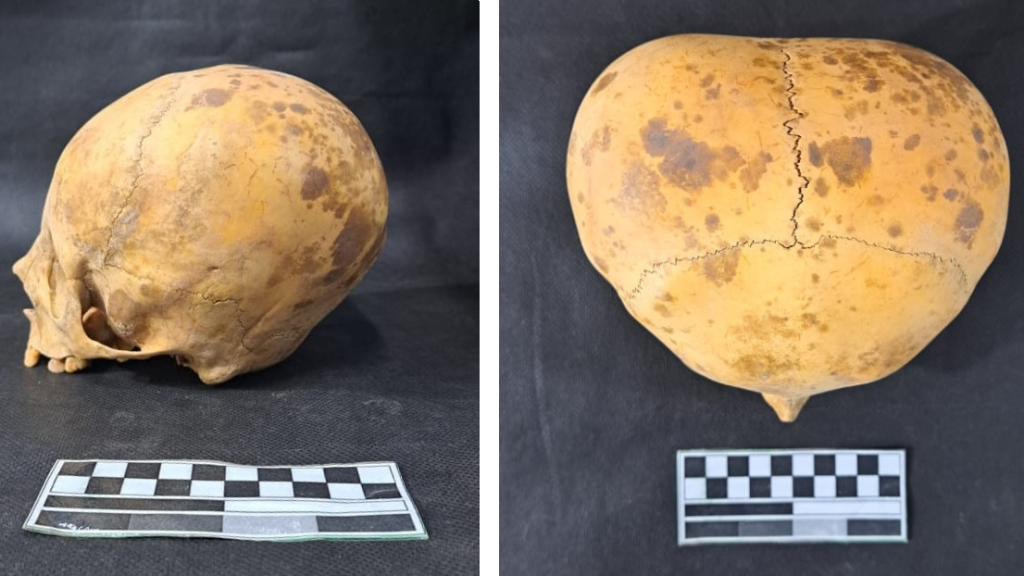Now Reading: This ancient Egyptian left behind 4,500-year-old DNA. It was used to recreate his face.
-
01
This ancient Egyptian left behind 4,500-year-old DNA. It was used to recreate his face.
This ancient Egyptian left behind 4,500-year-old DNA. It was used to recreate his face.

Sealed in a ceramic funerary pot, knees curled to his chin, the Egyptian skeleton lay undisturbed for thousands of years. In 1902, British archaeologists excavated him from his tomb carved into a limestone hillside in the Nuwayrat necropolis, more than 150 miles south of Cairo. While the pharaohs of his time built colossal monuments like the Great Pyramid of Giza, this man, likely a potter who lived 4,500 to 4,800 years ago, left behind a different kind of legacy: his exceptionally well-preserved DNA.
Somehow, his remains endured centuries of scorching Egyptian heat and even Nazi bombings while housed in Liverpool, England, during World War II. Now scientists have sequenced the first whole genome of an ancient Egyptian from intact DNA extracted from in his teeth. The study, published Wednesday in Nature, describes the oldest Egyptian DNA ever recovered, radiocarbon dated to between 2855 and 2570 B.C. This was during the end of the Early Dynastic and the beginning of the Old Kingdom periods, when Egypt’s rulers consolidated power and ushered in the “Age of the Pyramids.”
“There are hundreds, if not thousands, of ancient genomes from across the world,” says Linus Girdland-Flink, a biomolecular archaeologist at the University of Aberdeen in Scotland and a co-corresponding author of the paper. To date, scientists have collected ancient DNA from Neanderthals, Denisovans, and Homo sapiens from 45,000 years ago. “Yet, Egypt has remained a kind of white spot on the map of this big puzzle of human genetic ancestry.”
Previously, the oldest DNA recovered from ancient Egypt came from three mummies buried at the Abusir el-Meleq necropolis and dated between 787 and 23 B.C. But those sequences only represented partial genomes. The new genome is complete and comes from an individual who lived some 1,500 years earlier.

Pottery coffin and archaeological remains of the Nuwayrat individual, as discovered in 1902.
Photograph Courtesy Garstang Museum, University of Liverpool
“This genome allows us–for the first time–to get insights into the genetic ancestry of an ancient Egyptian individual from the Old Kingdom period,” Adeline Morez Jacobs, a biological anthropologist who conducted the research while pursuing her doctoral degree at the Liverpool John Moores University, said during a press briefing. It also allowed for scientists to partially reconstruct what the person’s face might have looked like.
Daniel Antoine, head of the department of Egypt and Sudan at The British Museum in London, who peer-reviewed the paper, praised the work. “Although this is based on one individual, the finding is highly significant as ancient DNA rarely survives in the Nile valley,” he says. With it, scientists can start to unravel genetic clues to how different populations of people interacted in ancient Egypt.
Ancient genetic ancestry revealed
With the DNA sequenced, scientists can start to ask questions about this ancient individual, starting with a basic one: who were his ancestors? While this is the lineage of just one person, it could help historians understand how people migrated and mixed in ancient Egypt.
About 80 percent of the man’s ancestry traces back to Neolithic populations in North Africa. The remaining 20 percent is linked to ancient peoples from West Asia, including Mesopotamia and the eastern Fertile Crescent, which encompass present day Iraq, western Iran, parts of Syria and the extreme southeast of Turkey, Morez Jacobs says. They did not find evidence of East African or sub-Saharan African ancestry in the Nuwayrat individual.
The researchers don’t know when in the Nuwayrat man’s lineage these two populations mixed, but say it likely occurred over hundreds or even thousands of years in the man’s ancestry, and maybe multiple times. This genetic data aligns with archaeological evidence, suggesting that in addition to trading goods like crops, animals and culture like writing systems and the pottery wheel, people themselves were moving and intermingling between regions.
“The paper constitutes a significant milestone in the field of ancient Egyptian genomics,” says Yehia Gad, scientific supervisor of the ancient DNA lab at the National Museum of Egyptian Civilization in Cairo, who was not involved in the study. He says the new finding “reinforces the status of ancient Egypt as a hub and melting pot of the old world.”
You May Also Like
The next steps for the team, says Girdland-Flink, is to collaborate with Egyptian scientists to further decipher Egypt’s past. Gad, who helps lead Egypt’s national genome project, which aims to sequence the genomes of 100,000 Egyptian adults and 200 ancient Egyptian mummies, says he welcomes the idea. “We can all serve and work together to draw a better picture of this fascinating ancient civilization, which constitutes an important stage in the journey of humanity,” he says.
Facial reconstruction and potential controversy
In addition to sequencing the Nuwayrat man’s genome, the researchers also unveiled a facial reconstruction made by forensic anthropologist Caroline Wilkinson. Wilkinson, who leads the Face Lab at Liverpool John Moores University, previously recreated the faces of figures like Ramesses II and Cleopatra’s sister Arsinoë IV.
Starting with a 3D scan of his skull, she constructed his facial features like the jawline, nose, and eyes—body parts that are relatively easy to predict from bone structure alone, she says. The ears and mouth, by contrast, are more difficult. Genetic analysis suggested the man likely had brown eyes, brown hair and skin pigmentation “ranging from dark to black skin,” based on predictions from a tool called the HirisPlexS system. But the authors caution that these predictions come with some uncertainty given the limited genetic data from comparable ancient populations.

Pottery vessel in which the Nuwayrat individual was discovered.
Photograph Courtesy Garstang Museum, University of Liverpool

Rock-cut tombs at Nuwayrat enclosing the pottery vessel containing the pottery coffin burial.
Photograph Courtesy Garstang Museum, University of Liverpool
To avoid speculation about features they could not definitively determine, Wilkinson says, she and her team rendered the reconstruction in grayscale, without hair or skin tone. She added that she expects the image to spark some controversy, as past depictions of other ancient Egyptians have. They are often criticized for appearing “too European” or “too African,” she says.
But Wilkinson emphasizes that the face is just what one person in antiquity looked like. “This individual is not representative of everybody from this period of time from this part of the world, any more than I am representative of everybody in Europe today.”
For more insights into who this person was, and the life he led, scientists needed to look beyond his face. His worn teeth suggested he was between 44 and 64, though likely at the older end. His skeleton showed signs of age-related arthritis, worn joints and vertebrae, and muscle strain from frequent squatting and leaning, patterns consistent with physically demanding pottery work, says Joel Irish, a bioarchaeologist at Liverpool John Moores University and a co-author of the study.
“He was looking down a lot during his lifetime, like teenagers look at their cell phones today,” says Irish. The team concluded from these clues and by studying hieroglyphics of pottery workshops that the man was likely a potter as opposed to a baker, farmer, mason or soldier. Though they could not rule out weaver. The team speculated that if he were a potter, then perhaps there may be some link between his profession and why he was buried in the ceramic pot. But they also added that the practice wasn’t unique to potters, this time period, or Nuwayrat.
But what about pyramid builder? Was the Nuwayrat man hauling huge stones in Giza (more than a hundred miles away from where he was buried)?
That’s “pure speculation” says Girdland-Flink. He also cautions against drawing conclusions about the people who constructed the pyramids based on this one ancient Egyptian genome.” In terms of who built the pyramids,” Girdland-Flink says, “you must have the actual workers’ genomes.”























